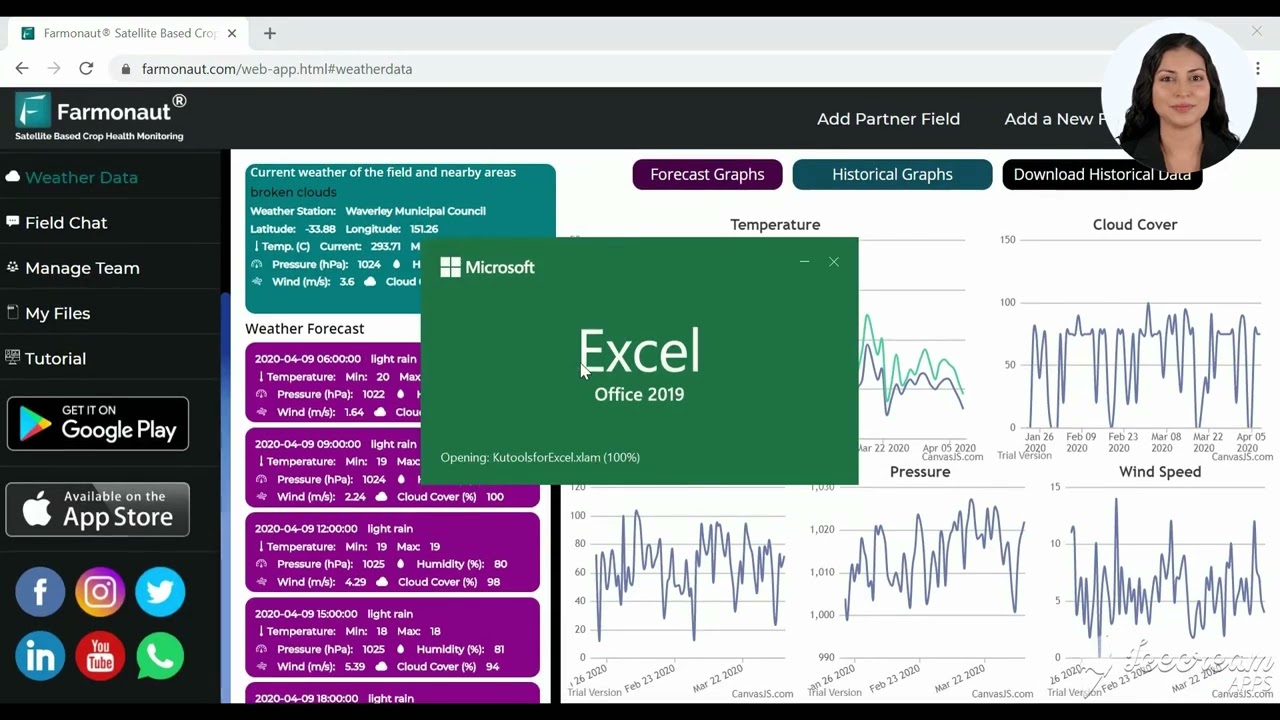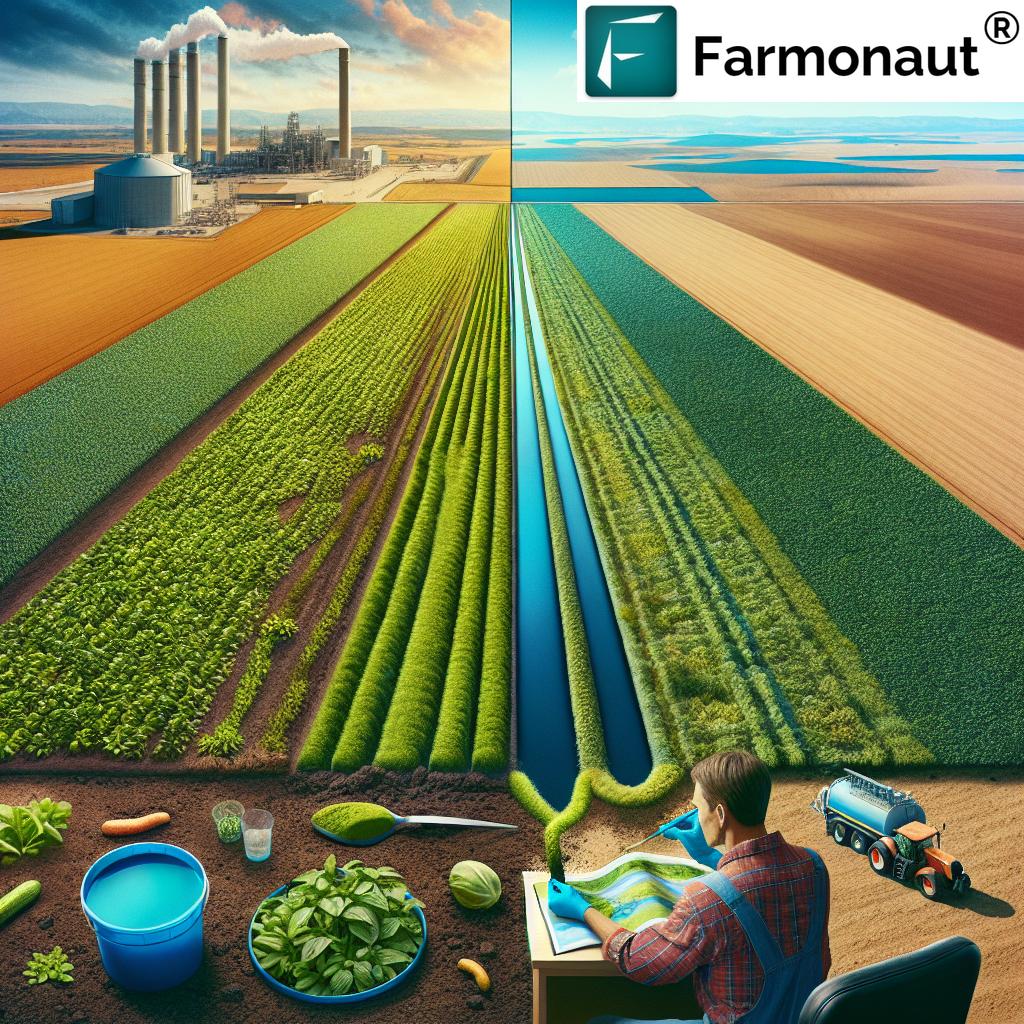Ultimate Guide: Long-Range Weather Forecast and Gardening Tips for Northeast Farmers

Welcome to our comprehensive guide on long-range weather forecasts and gardening tips for Northeast farmers! Whether you’re a seasoned grower or just starting out, this resource will provide you with invaluable insights to help you plan your outdoor activities, optimize your garden’s potential, and embrace sustainable farming practices. At Farmonaut, we’re committed to making precision agriculture accessible to farmers worldwide, and this guide is just one way we’re working towards that goal.
“Lunar phases influence gardening success: 29.5-day moon cycle affects plant growth and harvest timing.”
Understanding Long-Range Weather Forecasts for the Northeast
Long-range weather forecasts are essential tools for farmers and gardeners in the Northeast. These predictions help us plan our planting schedules, prepare for potential weather-related challenges, and make informed decisions about crop management. Let’s dive into what you can expect in the coming seasons:
- Fall: Expect crisp air and milder temperatures, with occasional showers. It’s an ideal time for harvesting late-season crops and preparing your garden for winter.
- Winter: The Northeast typically experiences cold temperatures and significant snowfall. Be prepared for frosty conditions and plan indoor gardening activities.
- Spring: As temperatures begin to rise, expect fluctuating weather patterns with a mix of rain and sunny days. This is the time to start seedlings and prepare your outdoor garden beds.
- Summer: Warm temperatures and longer days characterize Northeast summers. Be ready for occasional heat waves and plan your watering schedule accordingly.
Remember, these are general trends, and specific conditions can vary based on your exact location within the Northeast region. Areas closer to the Great Lakes, for example, may experience lake-effect snow in winter, while coastal regions might see more moderate temperatures year-round.
Seasonal Weather Patterns and Their Impact on Gardening
Understanding seasonal weather patterns is crucial for successful gardening in the Northeast. Here’s how each season affects your gardening activities:
- Fall: As temperatures cool, focus on harvesting remaining summer crops and planting cold-hardy vegetables like kale and Brussels sprouts. It’s also an excellent time for soil amendment and planting spring-flowering bulbs.
- Winter: While outdoor gardening is limited, use this time for planning, ordering seeds, and maintaining tools. Consider starting a winter garden indoors or in a greenhouse.
- Spring: As the soil thaws, begin preparing your garden beds. Start warm-season crops indoors and plant cool-season vegetables directly in the garden. Be prepared for late frosts and protect tender plants.
- Summer: This is the peak growing season. Regular watering, weeding, and pest management are essential. Harvest crops as they ripen and consider succession planting for continuous yields.
At Farmonaut, we provide real-time satellite-based crop health monitoring that can help you track how these seasonal patterns affect your crops. Our web app offers valuable insights into vegetation health, soil moisture levels, and other critical metrics to support your decision-making throughout the year.
Gardening Tips for Beginners in the Northeast
If you’re new to gardening in the Northeast, here are some essential tips to get you started:
- Know your hardiness zone: The Northeast spans several USDA hardiness zones. Determine your specific zone to choose plants that will thrive in your local climate.
- Start small: Begin with a few easy-to-grow vegetables or flowers to build your confidence and knowledge.
- Prepare your soil: Northeast soils can be acidic. Test your soil and amend it as needed with organic matter and appropriate fertilizers.
- Choose native plants: Native species are adapted to local conditions and generally require less maintenance.
- Extend your growing season: Use techniques like raised beds, cold frames, or row covers to protect plants from early and late frosts.
Our Jeevn AI Advisory System at Farmonaut can provide personalized recommendations based on your specific location and growing conditions. It’s like having an expert gardener at your fingertips!
Raised Bed Gardening Guide
Raised bed gardening is an excellent method for Northeast gardeners, offering better soil drainage, earlier planting times, and easier maintenance. Here’s a quick guide to get you started:
- Choose the right location: Select a spot that receives at least 6-8 hours of sunlight daily.
- Build your beds: Construct beds that are 3-4 feet wide for easy access from both sides. The length can vary based on your space.
- Fill with quality soil: Use a mix of topsoil, compost, and organic matter to create a nutrient-rich growing medium.
- Plan your planting: Maximize space by using square foot gardening techniques or companion planting.
- Maintain and water: Raised beds may dry out faster, so monitor soil moisture regularly.
With Farmonaut’s satellite-based monitoring, you can track the health of your raised bed gardens and make data-driven decisions about watering and fertilization.
Lunar Planting Calendar and Celestial Events
Many gardeners in the Northeast follow lunar planting calendars, believing that the moon’s phases influence plant growth. Here’s a basic guide:
- New Moon to First Quarter: Plant above-ground crops with exterior seeds.
- First Quarter to Full Moon: Plant above-ground crops with interior seeds.
- Full Moon to Last Quarter: Plant root crops and perennials.
- Last Quarter to New Moon: Focus on soil preparation and weed control.
Additionally, keep an eye out for celestial events like meteor showers, which can be a magical experience for nighttime gardeners. The Perseid meteor shower in August is particularly spectacular in the Northeast skies.
“Hardiness zone maps divide regions into 13 distinct zones, helping gardeners choose suitable plants for their area.”
Best Days for Planting Vegetables
While the specific best days for planting can vary based on local conditions, here are some general guidelines for Northeast vegetable planting:
- Cool-season crops (e.g., lettuce, peas, spinach): Plant as soon as the soil can be worked in early spring.
- Warm-season crops (e.g., tomatoes, peppers, cucumbers): Wait until after the last frost date, typically in late May or early June.
- Fall crops (e.g., broccoli, carrots, kale): Plant in mid to late summer for a fall harvest.
Remember to consult your local extension office for specific planting dates in your area. At Farmonaut, our AI-driven advisory system can provide personalized planting recommendations based on real-time weather data and historical patterns.
Companion Planting Techniques
Companion planting is a smart strategy for Northeast gardeners to maximize space and improve crop health. Here are some popular combinations:
- Tomatoes and Basil: Basil repels tomato hornworms and improves tomato flavor.
- Carrots and Onions: Onions deter carrot flies, while carrots repel onion flies.
- Beans and Corn: Beans fix nitrogen in the soil, benefiting corn growth.
- Lettuce and Tall Plants: Lettuce benefits from the shade provided by taller plants in hot summers.
Experiment with different combinations to find what works best in your garden. Our Farmonaut app can help you track the success of your companion planting efforts through regular satellite imagery analysis.
Soil Health and Fertilization
Maintaining healthy soil is crucial for successful gardening in the Northeast. Here are some tips:
- Test your soil: Conduct annual soil tests to understand nutrient levels and pH.
- Add organic matter: Incorporate compost or well-rotted manure to improve soil structure and fertility.
- Use cover crops: Plant cover crops like clover or rye in the off-season to prevent erosion and add nutrients.
- Practice crop rotation: Rotate crops annually to prevent soil depletion and reduce pest problems.
- Apply organic fertilizers: Use natural fertilizers like fish emulsion or bone meal for slow-release nutrients.
Farmonaut’s satellite-based monitoring can help you track soil moisture levels and vegetation health, providing insights into your soil’s overall condition.
Sustainable Farming Practices for Northeast Gardeners
Embracing sustainable farming practices is not only good for the environment but can also improve your garden’s productivity. Here are some techniques to consider:
- Water conservation: Use mulch to retain soil moisture and consider installing a rainwater harvesting system.
- Integrated Pest Management (IPM): Use natural predators, companion planting, and manual removal to control pests before resorting to chemicals.
- Composting: Create your own nutrient-rich soil amendment by composting kitchen scraps and yard waste.
- No-till gardening: Minimize soil disturbance to preserve soil structure and beneficial organisms.
- Polyculture: Grow a diverse range of crops to improve biodiversity and reduce pest pressure.
At Farmonaut, we’re committed to promoting sustainable agriculture. Our platform can help you monitor the impact of these practices on your garden’s health and productivity.

Organic Pest Control Methods
Northeast gardens can face a variety of pest challenges. Here are some organic methods to keep them at bay:
- Handpicking: Regularly inspect plants and remove pests by hand.
- Barrier methods: Use row covers or netting to protect plants from insects.
- Beneficial insects: Encourage ladybugs, praying mantises, and other helpful insects to your garden.
- Neem oil: This natural insecticide can control a wide range of pests.
- Diatomaceous earth: Sprinkle around plants to deter crawling insects.
Remember, a healthy garden is more resistant to pests. Use Farmonaut’s crop health monitoring tools to ensure your plants are in optimal condition.
Container Gardening for Small Spaces
Even with limited space, Northeast gardeners can grow a variety of plants in containers. Here’s how to get started:
- Choose the right containers: Ensure they have drainage holes and are appropriately sized for your plants.
- Use quality potting mix: Garden soil is too heavy for containers; use a well-draining potting mix instead.
- Select suitable plants: Many vegetables, herbs, and flowers thrive in containers. Try compact varieties for small spaces.
- Water regularly: Container plants dry out faster than in-ground plants, especially during hot Northeast summers.
- Fertilize appropriately: Container plants may need more frequent fertilization due to limited soil volume.
With Farmonaut’s AI-powered advisory system, you can receive tailored recommendations for your container garden, ensuring optimal growth even in small spaces.
Frost Dates and Hardiness Zone Maps
Understanding frost dates and hardiness zones is crucial for Northeast gardeners. Here’s what you need to know:
- First and Last Frost Dates: These vary across the Northeast. Know your specific dates to plan planting and harvesting schedules.
- Hardiness Zones: The Northeast spans zones 3-7. Identify your zone to choose plants that can survive your local winter temperatures.
- Microclimate Considerations: Local factors like urban heat islands or proximity to water bodies can create microclimates that differ from the broader zone.
Farmonaut’s weather data and AI advisory system can help you stay ahead of frost risks and make informed decisions about plant selection and protection.
Growing Vegetables in the Northeast
The Northeast climate is suitable for a wide variety of vegetables. Here are some tips for popular crops:
- Tomatoes: Start indoors 6-8 weeks before the last frost date. Provide support and protect from late blight.
- Cucumbers: Plant in well-drained soil after all danger of frost has passed. Trellis for vertical growth.
- Carrots: Sow directly in the garden in early spring. Thin seedlings for proper spacing.
- Lettuce: Plant successive crops for continuous harvest. Provide shade in hot summer months.
- Onions: Plant sets or seedlings in early spring. Harvest when tops begin to fall over.
Use Farmonaut’s crop health monitoring tools to track the progress of your vegetable garden and identify any issues early.
Creating a Thriving Flower Garden
A beautiful flower garden can thrive in the Northeast climate. Here’s how to create one:
- Choose a mix of annuals and perennials: This ensures year-round interest and reduces replanting needs.
- Consider bloom times: Plan for a succession of blooms from spring through fall.
- Group plants with similar needs: Cluster plants with similar water and sunlight requirements.
- Incorporate native species: Native flowers are adapted to local conditions and support pollinators.
- Provide winter interest: Include plants with interesting bark, berries, or seed heads for winter appeal.
Farmonaut’s satellite imagery can help you monitor the health and growth of your flower garden, ensuring vibrant blooms throughout the season.
Monthly Gardening Activity Calendar for Northeast Farmers
| Month | Weather Forecast Summary | Recommended Gardening Activities | Celestial Events/Lunar Phases |
|---|---|---|---|
| January | Cold, snowy conditions | Plan garden, order seeds, maintain tools | Quadrantids meteor shower (early month) |
| February | Cold, potential for heavy snow | Start seeds indoors, prune dormant trees | Full Snow Moon (mid-month) |
| March | Fluctuating temperatures, possible late frost | Prepare garden beds, plant cold-hardy vegetables | Vernal Equinox (around 20th) |
| April | Milder temperatures, occasional frost | Plant cool-season crops, start warm-season seedlings | Lyrid meteor shower (late month) |
| May | Warming temperatures, increased rainfall | Plant warm-season crops, monitor for pests | Eta Aquarids meteor shower (early month) |
| June | Warm, possibility of early heat waves | Harvest early crops, maintain regular watering | Summer Solstice (around 20th) |
| July | Hot, potential for dry spells | Mulch to retain moisture, harvest summer crops | Delta Aquarids meteor shower (late month) |
| August | Hot, potential for thunderstorms | Plant fall crops, continue harvesting | Perseids meteor shower (mid-month) |
| September | Cooling temperatures, possibility of early frost | Harvest late summer crops, plant cover crops | Autumnal Equinox (around 22nd) |
| October | Cool, potential for first frost | Harvest remaining crops, plant garlic and bulbs | Orionids meteor shower (late month) |
| November | Cold, possibility of early snow | Clean up garden, protect perennials | Leonids meteor shower (mid-month) |
| December | Cold, snowy conditions | Review garden journal, plan for next year | Geminids meteor shower (mid-month) |
Leveraging Technology for Precision Agriculture
At Farmonaut, we believe in the power of technology to revolutionize farming and gardening. Our platform offers several tools to help Northeast farmers and gardeners:
- Satellite-Based Crop Monitoring: Track your garden’s health with real-time satellite imagery.
- AI-Powered Advisory System: Receive personalized recommendations based on your specific garden conditions.
- Weather Data Analysis: Access detailed weather forecasts to plan your gardening activities.
- Resource Management Tools: Optimize your use of water, fertilizers, and other resources.
To explore how Farmonaut can enhance your gardening experience, check out our web app, or download our mobile apps:
Preparing for Extreme Weather Events
The Northeast can experience various extreme weather events. Here’s how to prepare your garden:
- Heavy Rain: Ensure proper drainage in your garden beds. Consider raised beds in flood-prone areas.
- Drought: Mulch extensively and consider installing a drip irrigation system.
- Early Frost: Keep frost cloths or row covers on hand to protect tender plants.
- Heatwaves: Provide shade for sensitive plants and increase watering frequency.
- Hurricanes: Have a plan to secure or bring in container plants and garden structures.
Farmonaut’s weather forecasting tools can help you stay ahead of these events, allowing you to take proactive measures to protect your garden.
Conclusion
Gardening in the Northeast offers unique challenges and rewards. By understanding long-range weather forecasts, embracing sustainable practices, and leveraging technology, you can create a thriving garden that produces bountiful harvests and beautiful blooms. Remember, gardening is a journey of continuous learning and adaptation. With patience, persistence, and the right tools, you’ll soon be enjoying the fruits (and vegetables!) of your labor.
At Farmonaut, we’re here to support your gardening journey every step of the way. Our satellite-based monitoring, AI-powered advisory system, and comprehensive weather data can help you make informed decisions and optimize your garden’s performance. Whether you’re a beginner or an experienced gardener, our tools can help you take your Northeast garden to the next level.
Ready to revolutionize your gardening experience? Explore our subscription options below:
Frequently Asked Questions
Q: How accurate are long-range weather forecasts for the Northeast?
A: Long-range forecasts provide general trends rather than specific day-to-day predictions. They’re most reliable for identifying seasonal patterns and potential extreme weather events. For more accurate short-term forecasts, refer to Farmonaut’s weather data tools.
Q: What are the best vegetables to grow in a Northeast garden?
A: Some of the best vegetables for Northeast gardens include tomatoes, peppers, cucumbers, lettuce, kale, carrots, and peas. Cold-hardy vegetables like Brussels sprouts and cabbage also do well in this region.
Q: How can I extend my growing season in the Northeast?
A: You can extend your growing season by using techniques such as raised beds, cold frames, row covers, and greenhouses. Starting seeds indoors and choosing cold-hardy varieties can also help you make the most of the Northeast’s shorter growing season.
Q: What is companion planting, and why is it beneficial?
A: Companion planting is the practice of growing different plants together for mutual benefit. It can help improve soil fertility, deter pests, attract beneficial insects, and maximize space utilization. For example, planting basil near tomatoes can improve tomato flavor and repel certain pests.
Q: How can Farmonaut’s technology help me with my Northeast garden?
A: Farmonaut’s satellite-based monitoring can provide real-time insights into your garden’s health, including vegetation indices and soil moisture levels. Our AI-powered advisory system offers personalized recommendations based on your specific garden conditions and local weather patterns. These tools can help you make data-driven decisions about watering, fertilization, and pest management.
We hope this guide has provided you with valuable insights for your Northeast gardening journey. Remember, successful gardening is a blend of science, art, and patience. With the right knowledge, tools, and a bit of nature’s cooperation, your garden will thrive. Happy gardening!



















